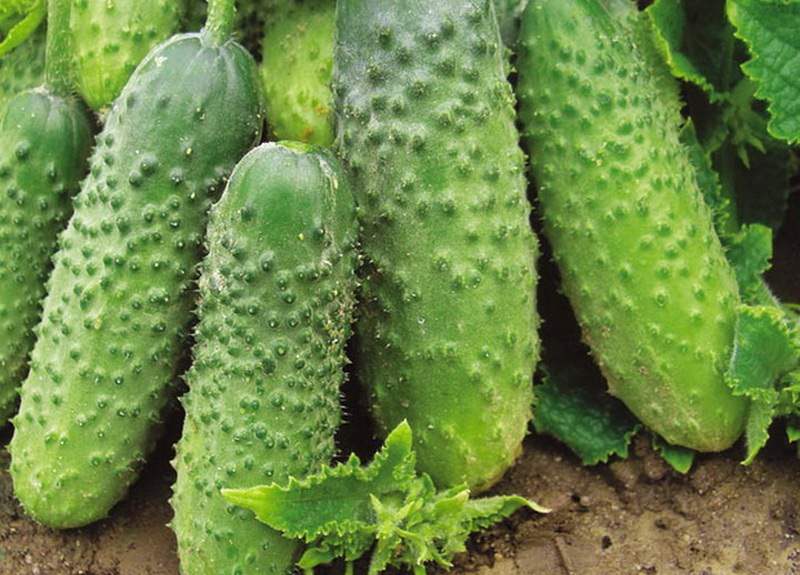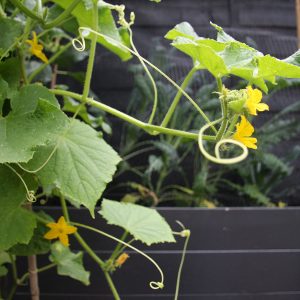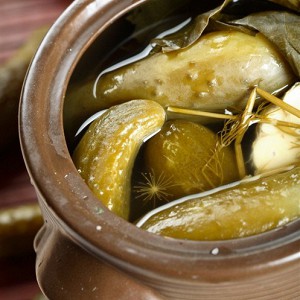An early ripe cucumber that does not require pollination Murashka from domestic breeders
Goosebump f1 is a popular early ripening hybrid that can be grown not only in the garden, but also on the balcony. 1 kg of cucumbers contains about 150 kcal, which makes this vegetable a dietary product. The cultivation technology of Goosebumps f1 is no different from the agricultural technology of other varieties. Read everything about the features of growing these cucumbers in our article.
The content of the article
Description
Cucumber Goosebump f1 is a hybrid that does not need insect pollination, which makes it easy to grow in greenhouse conditions. Bushes are not limited in growth. There are many leaves, their surface is smooth. The ovary is formed from female flowers. Fruiting type - bouquet, short internodes. One knot forms three to six ovaries.
Distinctive features
Externally, cucumbers have the same cylindrical shape, pronounced tubercles and dark prickly thorns (see photo). The color of the vegetables is green, from the base to the tip it becomes light green. There are light streaks that do not reach the end of the cucumber. Another distinguishing feature is the thin skin. The flesh is crispy and does not taste bitter.

Composition and properties
Cucumber is almost 95% structured water. The vegetable is an excellent thirst quencher. The remaining 5-7% contains useful minerals and vitamins: A, B1, B2, C, E, H, PP. In addition, it includes:
- starch;
- fructose;
- glucose;
- calcium;
- carotene;
- potassium;
- phosphorus;
- sodium;
- magnesium;
- iodine;
- ascorbic, caffeic and folic acids.
Calorie content per 100 g of product is 15 kcal:
- proteins - 0.8 g;
- fats - 0.1 g;
- carbohydrates - 3.0 g.
Specifications
The formation of lateral shoots is not intense. Plants bear fruit for a long time.
One bush growing in open ground yields up to 7 kg of yield, and in a greenhouse - up to 12 kg. The harvested fruits retain their freshness for a long time and have an excellent crunchy taste. The average weight of a vegetable is 90-100 g, length is up to 10-12 cm.But the plant also produces gherkins, which reach 7-8 cm.
Did you know? Cucumber is one of the oldest vegetables in the world. It was known even more than 6,000 years ago.
How to grow cucumbers yourself
Goosebumps f1 cucumbers are grown in two ways: seedlings and direct sowing in open ground. The first option gives the highest yield. Also, a good harvest is obtained in greenhouse conditions. But in any case, the seeds are disinfected by soaking in a 1% solution of potassium permanganate for 20-30 minutes. Then they are washed, wrapped in a damp cotton cloth and left to germinate at 25 ° C. As it dries, the seeds are moistened. When they hatch, they are placed in a refrigerator for hardening for 18 hours at a temperature of 2 ° C.
Seedling method
After germination, the seeds are placed in soil made of earth and humus mixed with wood ash. The grains are embedded to a depth of 1 cm in separate containers with drainage holes and covered with foil.
It takes two weeks for the seeds to germinate. Then the film is removed and the air temperature is lowered so that the plant stems do not stretch. As a top dressing, a solution of "Nitroammofoski" is used (20 g of powder per 10 l of water).
On a note. Murashka f1 cucumbers do not tolerate transplanting well, so the seedlings are grown in separate containers.
When two true leaves appear, the plants are transplanted to a permanent place of growth. This happens at the end of April or the first half of May. For 1 sq. m beds place three cucumber bushes.With this scheme, the yield will increase to 10-12 kg. The plant is very demanding on the fertility of the land, so the soil is well fertilized since autumn.
They are planted in open ground on the south side of the site so that the culture gets more sunlight. For the growth and development of cucumbers, the proximity of plants plays an important role.
Healthy neighbors of cucumbers:
The crop is not planted next to potatoes, radishes, radishes and tomatoes. Also, cucumbers are not grown from year to year in the same place. Experienced vegetable growers change the garden every time, choosing a place without drafts.
Seedless way
For direct sowing of seeds in open ground, wait for the soil to warm up to a depth of 15 cm to 18-23 ° С... The weather should be warm without sudden frosts. First, seed material is prepared: sorted, germinated, hardened. The seed preparation technique is similar to the preparation for planting seedlings.
Prepared grains are planted in holes. They are made at a distance of 70-80 cm from each other. About nine seeds are placed in the grooves and a little sprinkled with soil. When shoots appear, 2-3 of the strongest plants are left and tied to a support. The planting should not be thickened.
Growing and care
Murashka cucumbers f1 mainly grow at night, so they try to water them at this time. The plantings are moistened at the rate of 20 liters of water per 1 sq. m. When blooming, do not allow moisture to enter the bushes. Plants also need oxygen, for which the soil is loosened after watering.
Fertilizers are applied three times:
- The first feeding is done during fruit setting. To do this, use a mullein.
- Fertilize with a solution of manure with the addition of superphosphate.
- Before the cucumber begins to harvest, the plant is fertilized with ash.
As they grow, cucumbers need pinching and pinching:
- When the planted bushes take root and grow, they are tied to a support.
- At the bottom of the bush, "blinding" is carried out: four true leaves are removed.
- When the lash reaches 0.5-1 m in height, the lateral stems are pinched, leaving one ovary and the accompanying leaf.
- With the appearance of the seventh leaf (distance from the soil surface - 1-1.5 m), the lateral shoots are pinched after 2-3 ovaries with leaves.
- Pinch the top. After that, all the forces of the plant go to the side shoots, which has a positive effect on the amount of harvest.
Possible difficulties
The most suitable air temperature in the greenhouse during the daytime is 24-28 ° С, and at night - 18-22 ° С. On hot days, do not allow the air to be warmed up above 30 ° C. If the mercury strip goes higher, this can lead to premature aging of the bush and its further drying. At temperatures below the optimal level, fruit setting worsens, and yield indicators fall. On cloudy days, the optimum temperature for plants is 22-24 ° C.
On a note. The air temperature is controlled by opening or closing two opposite vents and watering the plants.
Diseases and pests
Cucumber Goosebump f1 is a capricious plant. If preventive measures are not taken, the culture can be exposed to diseases. Protection is carried out with special chemicals or folk remedies:
- To combat powdery mildew, the drugs "Quadris", "Jet" or "Topaz" are used.
- Bordeaux mixture or Quadris remedy will help with anthracnose.
- Cucumber mosaics are treated with Actellic or Aktara.
- With white or green speckled mosaics, cucumbers are sprayed with skim milk.
- If the first signs of downy mildew appear, the plants are treated with Kuproksat or Ridomil Gold.
- With the appearance of the first signs of cladosporium, copper oxychloride is used.
- For the prevention of root and white rot, use "Fitosporin-M".
- To get rid of aphids and spider mites, the plants are sprayed with soapy water (2 cups of ash and 200 g of grated laundry soap are stirred in 10 liters of water).
Any disease is easier to prevent than to cure. Compliance with the listed recommendations will help to grow a good harvest and provide the whole family with fresh cucumbers and winter harvests.
Harvesting and application of the crop
Since Goosebump f1 is an early ripening hybrid, a large amount of harvest is harvested per season. If the sowing was carried out in May, then the first fruits are removed already in mid or late June. When planting cucumbers in open ground, the crop is harvested until the end of August, when grown in greenhouse conditions - until mid-September.
Goosebumps f1 cucumbers do not have a bitter taste. The vegetable is consumed fresh. It shows its properties best at pickling or salting.
Advantages and disadvantages
Cucumber Murashka f1 is liked by vegetable growers due to a large list of advantages:
- stable high yield;
- excellent presentation;
- great taste;
- the possibility of growing in open ground, greenhouse and even on the balcony;
- versatility in use;
- early and long-term fruiting;
- self-pollination.
The culture has few drawbacks. These include:
- the likelihood of damage by peronosporosis and other diseases;
- unlimited growth of lashes, requiring the formation of plants;
- inability to use seeds from their harvest.
Reviews
Experienced vegetable growers evaluate Murashka f1 cucumbers mainly from a positive side. They are actively grown in the vast majority of regions of our country.

Vladimir, Orekhovo-Zuevo: “Experienced growers know how much the yield depends on the quality of the seeds. My wife and I always buy domestic, from the manufacturer "Gavrish". Of these, we like Murashka cucumber f1 very much. Planting and caring for it does not require much effort. In terms of yield and taste, it is in no way inferior to imported ones. The ovaries are formed by bouquets, without barren flowers. Zelentsy grows the same as in the photo, we collect them every day throughout the season. The culture bears fruit until the frost. All cucumbers grow on our trellises, so we form the bushes into one stem, remove unnecessary stepsons and cut off all antennae. We feed the plants only with organic matter. "
Nadezhda, Oryol: “I always wanted to grow my cucumbers on the loggia. After looking through the descriptions of different varieties, I stopped at Murashka f1. The soil was used ready-made, purchased. I got a pack of five grains and put it in a large wooden box. After three days, the seeds hatched. All the shoots were good, developed quickly, of which I left the two strongest ones. At the formation of the 9th leaf on the central stems, pinched the tops. Plants began to branch actively. After 1.5 months, the first fruits appeared. The taste of the cucumbers made me very happy: they are moderately sweet and completely without bitterness. My homemade cucumbers have been bearing fruit for two months and every day they delighted my family with a fresh harvest. "
Olga, Volgograd: “Only my favorite varieties grow on my cucumber garden. One of them is Goosebump f1. The main advantage of these cucumbers is early maturity and self-pollination. To obtain a bountiful harvest, it is only necessary to carry out timely watering and weeding. The cucumber taste is excellent and the size is suitable for both pickling and preservation. We have a large family, so we make a lot of preparations for the winter. We cork young cucumbers 7-8 cm long in jars, and salt those that grow up to 10-11 cm in a barrel. The fruits have large pimples with small black thorns. When salted, they do not lose crunchiness and elasticity, they are perfectly salted. "
Conclusion
Goosebump f1 cucumber has gained great popularity among vegetable growers. The hybrid showed itself well when grown in a greenhouse and open field. He is able to self-pollinate, bear fruit for a long time and grow even on the windowsill. The requirements for caring for the plant are standard: it must be regularly watered, fed and weeded. You should not thicken the planting and plant more than three bushes per 1 sq. m area.
To get a stable harvest for a long time, the fruits should be removed regularly, otherwise they will overload the lashes and prevent the formation of new ovaries. Despite the fact that this hybrid is not prone to outgrowth and loss of its presentation, the taste of fruits not picked in time may deteriorate.